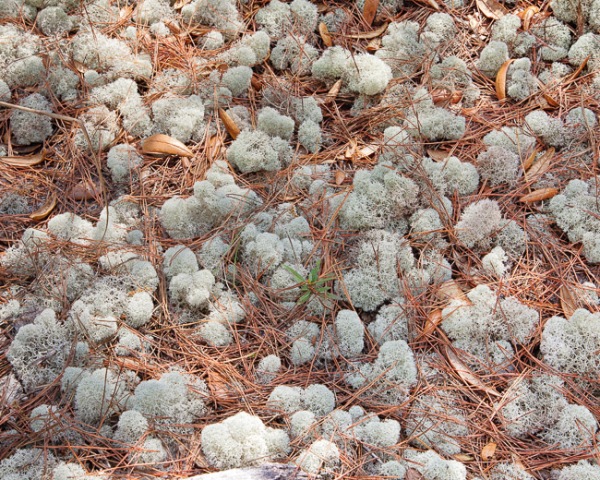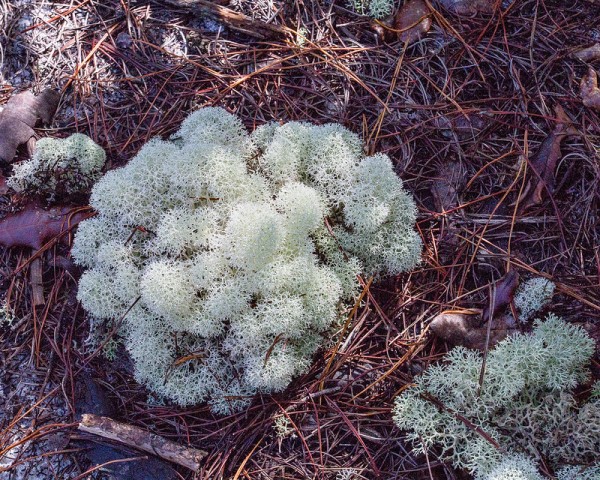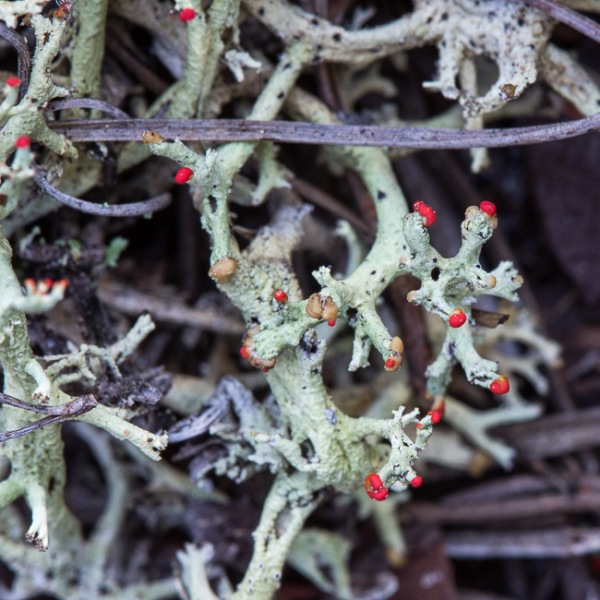Today I accompanied my wife Donna to Boynton Beach where she had work to do while I had botanical fun in the Hypoluxo Scrub Natural Area. My intent was to examine oak trees, but became distracted by the fairy forest of ground-dwelling lichens. Sorting out the local species seems a little boring and pedantic, as does re-re-repeating internet attention to the endangered “perforate cladonia,” or lecturing on “lichens 101” (moss-alga combo, extreme habitat tolerances, sensitive to air pollution, yada yada yada). The fragility of lichens complicates the application of prescribed burns and mechanical maintenance in scrubby habitats, although pockets of lichens tend to survive passing fires, thanks largely to the natural firebreaks of open sandy areas. Today let’s fool around with some less “internet-ized” aspects of soil-dwelling lichens. If you’d like to learn the basics about them, click here.

The textbook definition of a lichen is the symbiotic marriage of a fungus and alga. Botanists have long known of greater complexities, such as involving two species of fungi. Even better, bacteria lurking in lichens appeared in early 20th Century microscopes. Appreciation of their involvement in the lichen multispecies partnership, however, has gained modern currency thanks to molecular techniques. The bacteria are abundant, varied, and integrated into the lichen’s machinery, although their contributions to nutrient cycling, protection, and hormone production are just emerging.

It seems that the predominant bacteria in the types of “reindeer” lichens in Florida scrub are Alphoproteobacteria, a broad diversified group often involved symbiotically with other organisms. In 20-20 hindsight, it does seem that the old classroom dogma “the alga provides the sugars—the fungus does the rest” is too simplistic. After all, bacteria are players within me too, and with both lichens and my tummy, it’s sometimes unclear as to which bacteria are beneficial, which are mere tagalongs, and which are bad company.

An irksome question is the “purpose” of the scarlet coloration on the branch tips of species of “British Soldier” type lichens in the genus Cladonia. The red zones are the fungus’s spore-making organs called apothecia (app-oh-THEEK-ee-ah). Nobody knows to what extent lichens even use fungal spores for reproduction, given that being a combination organism, most lichen reproduction is by tiny flakes where bits of the alga and fungus flake off hand in hand. That said, the spores matter at some level, and are the only chance for fungal sexuality. So why do those spore-making apothecia have such shocking red tips? Good luck finding a trustworthy answer on the Internet. The obvious explanations each have one or more flaws:
1. The red tips attract insects to help disperse the spores (or help disperse the tiny adjacent two-species-flakes). Too bad combing the internet for any hint of insect visitors in text or photos comes up dry. Nothing!
2. The red tips are warning coloration. “Don’t eat me because I’m poison.” Some mammals, such as reindeer, eat lichens. Maybe Rudolf got his red tip from lichen DNA. The lichens with red tips are toxic, and the red pigment, rhodocladonic acid, is nasty. Thus warning coloration seems plausible except for this possible deal-breaker: other than primates, mammals generally have poor color vision, as Piotr Gąsiorowski pointed out discussing the warning coloration idea on a lichen blog. So much for that, unless the red colors deter arthropod herbivores, which do have good color vision, such as in insects visiting colorful pretty flowers. Mite damage reportedly can increase production of rhodocladonic acid.
(Note added after posting: After this blog was posted, Dr. Gabriele Gheza, lichen expert and author of Cladonia blog Cladonarium) e-mailed his informed views on the different hypotheses. Although he has reservations about how important mites are in the role of the red tips as such, he sent a link (Click) to the reference about mites inducing rhodocladonic acid…in parts of Cladonia lichens that are not red.)
Staving off mites and other tiny varmints doesn’t pass my personal gut-feeling test. Of course, colorful warnings aside, poisons may protect the lichens from color-blind munchers. I doubt that’s what the redness is all about nonetheless.
3. The red tips are sun protection. It seems odd that “sunscreen” would be so precisely localized on branch tips, but maybe protecting the sexual spore-bearing regions there prevents mutations. Why would sunscreen be bright eye-catching scarlet? I dunno. In other species related to the red-tip-types, the tips are merely brownish, pinkish, or purplish. Other living things, for example “red tip” cocoplum, shoebutton ardisia, Christmas lichens, red mushrooms, some sphagnums, and some bacteria have reddish pigments interpretable as sun protection. Lichen pigments, even when not fire engine red, have been demonstrated to protect sun-sensitive lichen tissues. So, if I’d have to bet, I place my money (but not much) on sun protection.